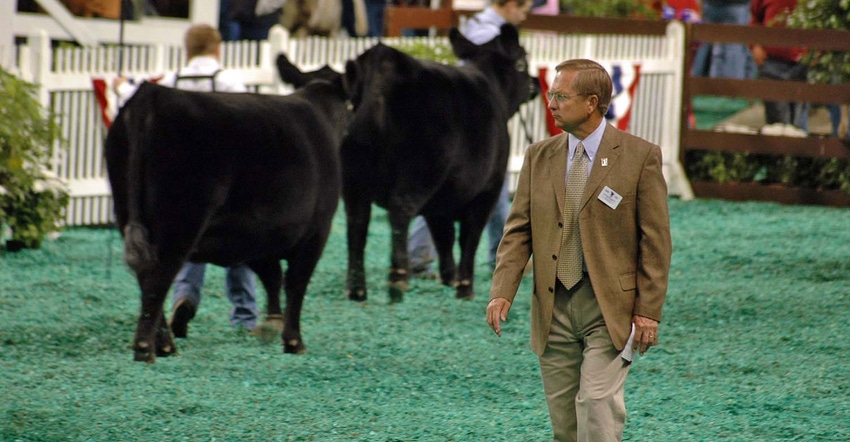September 15, 2022

It was 1987 on the University of Illinois campus. Students packed the sidewalks, headed to class and beyond. Amid the Frisbees and college kids and backpacks on the Quad, there was also a steer.
A little stiff. A little past his prime. A rescue, you might call him.
The steer was Broadus White Socks, literally stuffed and preserved since 1923, lost to the bowels of the English Building, then found. The rescuers were three animal scientists: Doug Parrett, Tom Carr and Dick Cobb.
And in Doug Parrett’s retelling of this story (picture him grinning and gesturing), the three of them wheeled the semi-famous, once-champion steer back home to the Stock Pavilion in the broad light of day. No sheet or tarp, no need to pick a time with fewer folks around. Just wheel him home. Reportedly, Cobb pretended to lead him by the halter. Students asked to pet him.
“Better not — he’s pretty wild!” Cobb told them. They all laughed.
And nobody relished the telling of that story like Doug Parrett.
Doug Parrett died last month. He was 71. He spent 49 years teaching, coaching and working in Extension at the University of Illinois. To his students, of course, he’ll always be Dr. Parrett.
I was one of those students, and I was one of thousands, but he always knew my name.
Somehow, he knew I grew up with Shorthorns, and he’d call on me in class, winking when he gave the lecture on why we only need three beef breeds (spoiler: not Shorthorns). I loved AnSci100 with him. I loved how excited he was about turning grass into protein. I loved how he taught with just as much excitement for those of us who grew up with livestock as he did for the pre-vet kids from the suburbs. I loved his message: This is where your food comes from, and this is how we take care of it.
Competitive teaching
If you’re thinking, “Hey, I took AnSci100 with him,” you’re in good company. According to Dan Shike, Dr. Parrett taught that course for the first time in spring 1988. Then he kept at it, teaching it every semester for 34 years. University enrollment records show that he taught 8,120 students — in Animal Sciences 100 alone.
He was deeply interested in those students, and they loved him for it. Not sure what to do with your life? Go see Dr. Parrett. Need life advice? Go see Dr. Parrett.
Shike would know; Dr. Parrett first recruited him, and then mentored him in livestock judging, teaching and life. The two of them taught beef production together the past 14 years.
“He was the master of captivating an audience,” Shike says. “On the first day of class, he would tell students that I would probably provide them with better science, but he would have the better stories!”
And you know a couple of international livestock evaluators were competitive. Dr. Parrett was obviously kind and compassionate, but he’d also come down at the end of the semester to see who “won” on teaching evaluations.
Dream team
For an entire generation (and maybe two), Doug Parrett and Tom Carr just went together. Parrett coached livestock judging. Carr coached meats judging. And together they coached the meat animal evaluation team for 31 years, winning the national championship 16 times.
Name a basketball coach with that kind of a record. Go ahead. I’ll wait.
What it really means is that for three decades, they crisscrossed the country together in a van, ate a lot of fast food, shared their faith and beliefs and concerns. They lost their dads at about the same time. It was tough on them, but they had each other to help shoulder the loss.
“We were just always together,” Dr. Carr told me.
And at the end of the day, isn’t that everything?
Sixteen national championships. Two best friends. Dozens of young people looking to them for advice or another way to almost swear.
Carr says Parrett was a good coach because he was a good teacher. “The kids knew he was very interested in them, and in them succeeding in life,” Carr says. “You’re gonna pay attention to somebody that cares about ya.”
There’s a term called the butterfly effect. Technically, it was the first name for the chaos theory in mathematics, but in popular culture, it’s come to describe the outsize significance of minute occurrences. Most recently, I heard it used to describe how one person can encourage and motivate and impact lives across all sorts of sectors; then those people impact other people, and so on and so forth.
Doug Parrett coached hundreds of livestock judgers, taught thousands of students, encouraged beloved colleagues for 49 years. Those relationships have rippled in ways we’ll never be able to measure. But gosh, they’re fun to remember.
Few of us have his flair for teaching or storytelling. But we can care about people.
And that may be the best lesson Dr. Parrett ever taught.
Comments? Email [email protected].
You May Also Like




